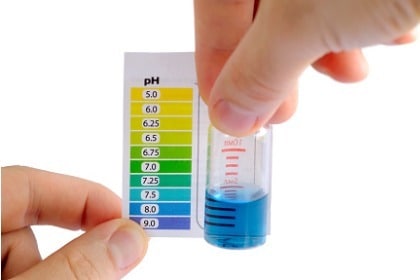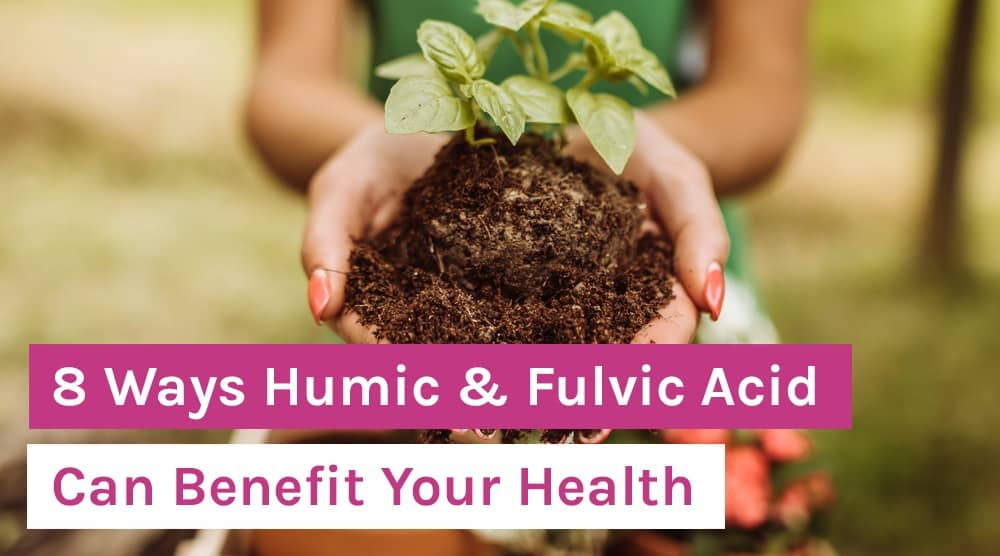8 Ways Humic & Fulvic Acid Can Benefit Your Health
In a hurry? Click here to read the Article Summary...
You may have noticed that some supplements contain a “Carbonic Organic Acid Blend” of Humic Acid and Fulvic Acid. But just what is humic and fulvic acid and what possible benefit can it have in a supplement?
What Is Humus?
Humic and fulvic acids can best be described as “loose assemblies of aromatic organic polymers” which are naturally present in humus, or so-called “humic shale” in soil, sediment, and watery environments.
Humus (not to be confused with hummus, the savory dip that’s delicious with veggies and crackers 🙂 ) is a thick, dark brown or black organic material that forms in the upper layers of soil. It comes from plant and animal remains that decay into their most basic chemical elements, thanks to the action of microorganisms or microbes in the soil.

Many of these chemicals are very important nutrients for plants, bacteria, and other organisms. Humus is vital for plant health – and both humic and fulvic acids are common soil additives.
They help to make soil more fertile, allow air and water to move easily through soil, and make vital oxygen more accessible to plants – especially their roots.
Fulvic Acid Is a Type of Humic Acid
Structurally speaking, humic and fulvic acids are unique, complex mixtures of many different molecules with similar chemical properties. In fact, you could say that fulvic acids are actually a type of lightweight humic acid with high oxygen content.
Fulvic acids have nutritional benefits, while non-fulvic humic acids act to protect living organisms – both plants and animals – against viruses and bacteria. Together, they also help to form a unique, highly efficient delivery system for vitamins and minerals, enabling maximum nutrient absorption, retention, and use.
What Is Humic Acid?
Humic acid molecules are larger and more complex than fulvic acids. They also contain more positively charged particles, mostly metals, that act as minerals in the soil.
Further, humic acids have been shown to improve plant growth rate better than standard fertilizers, without associated toxicity. When taken up by plants, humic acids help them to sustain a healthy, physiologically active state for a longer period of time.

Humic acids chelate (bind strongly) to so-called “heavy metals” including ferric iron, lead, and copper, as well as pesticides and other pollutants, making them very effective in helping to eliminate many of the toxic waste pollutants contaminating our soil and water today.
What Is Fulvic Acid?
Fulvic acids are ultra-low molecular weight organic mixtures of different molecules with similar chemical properties, believed to have been generated by thousands of years of composting, or breakdown of plant and animal-based material in the soil. No wonder health experts call them the “last rung on the decomposition ladder.”
Where Does Fulvic Acid Come From?
Rare shale deposits – areas with multiple layers of compressed fulvic shale that are typically rich in minerals and trace elements – are rich in fulvic acids.
Their name derives from the Latin fulvus, indicative of their typical yellow color. Fulvic acids stabilize the soil and enable plants to easily take up and use the many vital nutrients they need. As mentioned earlier, they are absolutely essential for plant health.
Structurally, fulvic acids are very small “nanomolecules” containing highly active, or unspent, carbon, hydrogen, molecular oxygen, and up to 60 different minerals. They are soluble in water and all pH conditions (acidic, neutral, and alkaline).
Fulvic Acid Benefits: 8 Ways Fulvic Acid Supports Good Health
Fulvic acids have many vital actions in the body. In fact, life as we know it would not exist without them.

They are important for our health because they help to make nutrients readily available to us. They also balance and energize the body’s cells, along with helping to stabilize and maintain multiple biological processes within them.
Let’s take a closer look at some of the properties of fulvic acids to better understand their many health-giving actions in the body.
#1. Fulvic Acids Promote Gut Health
Fulvic acids improve gut health, most likely because they contain nutrients that support the growth of beneficial bacteria in our gut.
Indeed, consumption of fulvic acids has been shown to reduce the incidence of digestive disorders such as SIBO (small intestine bacterial overgrowth) and inflammatory bowel disorders, along with reducing constipation, diarrhea, bloating, and food sensitivities.
Interestingly, an ancient natural remedy found mainly in the Himalayas known as “Shilajit” has been used for hundreds of years in traditional Indian Ayurvedic medicine to treat poor digestive and immune health.
Shilajit is also believed to be formed over centuries by the gradual decomposition of certain plants by microorganisms – and in fact, 60%-80% of Shilajit is made up of fulvic and humic acids.
#2. Fulvic Acids Help to Balance Our Electrochemistry

Fulvic acids are powerful electrolytes that help to keep the body’s electrochemistry in balance and keep our cells optimally charged and healthy. This makes fulvic acids powerful protective agents against aging- and disease-related degenerative processes.
Fulvic acids are able to conduct electric currents when dissolved in water or other liquids, helping to maintain the health of our cells by balancing their electrical potential and allowing the free flow of electrons and other ions.
Cellular electrochemical balance can be negatively affected by a number of factors, including fluid loss, emotional stress, sleep deprivation, lack of exercise, and poor nutrition. By maintaining the electrochemical balance in our cells, fulvic acids help to defend them against harm and may even help to prolong their lifespan.
#3. Fulvic Acid Boosts Nutrient Transport and Utilization
Amazingly, fulvic acids can bind to up to 60 times their weight in nutrients! In fact, mineral absorption without prior chelation by fulvic acids is only about 10% as effective. Fulvic acids also allow minerals to regenerate and interact with one another, enhancing their availability.

Fulvic acids transport nutrients very efficiently to the body’s tissues. This is because they are easily absorbed into the bloodstream through our gut. This dramatically increases the body’s ability to absorb them and boosts our overall health and well-being.
Further, because of their very low molecular weights, fulvic acids can easily pass through the protective membranes of cells in nearly all of the body’s tissues, helping to absorb nutrients such as vitamins and minerals – and even other supplements – faster and keeping them in the body longer.
In general, fulvic acids improve the overall retention, absorption, and utilization of nutrients present in our food and supplements. In fact, without fulvic acid, vitamins and minerals are of very little use to the body.
#4. Fulvic Acids Counter Free Radical Damage
In combination with active carbon and high molecular oxygen, fulvic acids are powerful antioxidants and cleansers, acting to counter harmful oxidative damage caused by free radicals.
When fulvic acids encounter free radicals, they provide equal and opposite charges which neutralize them, thereby protecting our cells and cellular components from the damaging effects of oxidation.
In other words, fulvic acids are crucial for the prevention, even reversal, of health conditions associated with free radical damage caused by environmental toxins and pollutants, thereby helping to slow the aging process.
#5. Fulvic Acids Dramatically Improve Metal and Mineral Availability
Fulvic acids also chelate and form strong complexes with many metals, including “ferric” iron, aluminum, and copper, increasing their ability to dissolve in water. In the process, these metallic minerals dissolve into ionic form, merging into the fulvic structure and becoming biochemically reactive and mobile.
In other words, fulvic acids transform minerals and metals into elaborate fulvic acid-based complexes with vastly different properties than their previous metallic mineral forms.

In this way, fulvic acids in the soil make minerals and metals more readily available to plants. For instance, iron is normally not very mobile. However, it is easily taken up by plants thanks to fulvic acids. Fulvic acids also help to dissolve and transport vitamins, coenzymes, and other necessary substances from the soil into plants.
Similarly, fulvic acids chelate heavy metals in the body, allowing them to move more easily and making them more readily available for the body to expel.
#6. Fulvic Acid Is a Powerful Detoxing Agent
Fulvic acids can bind to pollutants such as pesticides and herbicides, catalyzing their breakdown and dispersal.
Similarly, fulvic acids help chelate and remove accumulated waste and toxic materials from our body. Radioactive substances also react rapidly with fulvic acids to form inactive complexes that can then be removed from the body.
#7. Fulvic Acid Enhances Vitamin Activity
Thanks to scientific advances, many common vitamin deficiency diseases have been reduced or eliminated because of our increasing awareness of the role of vitamins in nutrition. However, vitamins cannot function efficiently without the presence of certain specific mineral “cofactors.”
As we know, fulvic acids chelate and bind many minerals into bioavailable forms that can easily be used by our body, thereby providing vitamins in our body with their essential cofactors.
Not only that, fulvic acids are also very efficient transporters of vitamins into our cells.
#8. Fulvic Acids Help Protect Skin

Supplementation with fulvic acids has been shown to improve symptoms associated with eczema.
Topical application of fulvic and humic acids has been shown to protect the skin and help in treating wounds, scratches, and rashes. Fulvic acid has also traditionally been used as a remedy for poison ivy, poison oak, and athlete’s foot.
Reasons Why We’re Absorbing Fewer Nutrients
Our body is constantly under attack by hundreds of thousands of environmental toxins and pollutants. Further, thanks to modern farming practices, our soils have been contaminated by pesticides and chemical fertilizers that not only endanger our health but also contribute to soil erosion and nutrient depletion.
As a result, our foods contain far fewer nutrients, including fulvic acids, in much lesser quantities than before. In other words, nowadays we get fewer nutrients and our ability to properly use whatever nutrients are in our foods is also impaired. This weakens our immune system and makes us more vulnerable to infections and diseases.
Health experts say we need up to 90 different nutrients in our diets, more than 60 of which are minerals and trace elements. However, the sad fact is that we are simply not getting them from the standard American diet.
And although many people take various supplements regularly, the body cannot use many of the nutrients in these supplements without a helping hand from fulvic acids.

As you have already learned, fulvic acids are excellent natural chelators that bind strongly to nutrients, minerals, and metals to form stable, water-soluble complexes, dramatically improving their absorption and enhancing their bioavailability in the body.
Fulvic acids also help to restore the body’s optimal pH level, its defenses against harmful bacteria, fungi, yeast, and other infectious organisms.
With fulvic acid supplementation and a return to proper diet and farming practices, we can better fulfill our hope of living longer, healthier lives.
If you’re not getting all the nutrients and antioxidants you need from food, your best source is whole food vitamins. Organixx Multi-Vita-Maxx contains 21 uniquely fermented vitamins and enzyme-activated minerals that are more “bioavailable” and easily absorbed by your body than the synthetic compounds found in most supplements.

 Sources:
Sources:
Article Summary
Humic and fulvic acids are “loose assemblies of aromatic organic polymers” which are naturally present in humus, or so-called “humic shale” in soil, sediment, and watery environments.
Humus is a thick, dark organic material that forms in the upper layers of soil. It’s made from the breakdown of plants and animals into their chemical elements.
Structurally speaking, humic and fulvic acids are unique, complex mixtures of many different molecules with similar chemical properties.
Fulvic acids are a type of lightweight humic acid with high oxygen content. They stabilize the soil and enable plants to easily take up and use the many vital nutrients they need.
Fulvic acids have many vital actions in the body. Life as we know it would not exist without them.
Here are 8 ways fulvic acids support good health:
- They promote gut health by supporting the growth of beneficial bacteria in our gut.
- They help to keep the body’s electrochemistry in balance and cells optimally charged and healthy.
- Fulvic acids allow minerals to regenerate and interact with one another, enhancing their availability.
- They are powerful antioxidants and cleansers, acting to counter damage caused by free radicals.
- Fulvic acids chelate heavy metals in the body, making it easier for the body to expel them.
- They can bind to pollutants (e.g., pesticides and herbicides) catalyzing their breakdown and dispersal.
- Fulvic acids are efficient transporters of vitamins into our cells.
- Topical application of fulvic and humic acids has been shown to protect the skin and help in treating wounds, scratches, and rashes.




Where can I find the nutritional content for the Liquid Multi-Vita-Max?
Hi Barbara, thank you for your question and interest.
You may find the Liquid Multi-Vita-Maxx Product Label here: https://cdn.shopify.com/s/files/1/1569/1827/products/Liquid-MultiVitaMaxx-label-back_1024x1024.png?v=1535159935
If you would like to learn more about our product, we encourage you to check out the following links:
Shop/Reviews Page: https://shop.organixx.com/collections/all-products/products/liquid-multi-vita-maxx
Product Info Page: https://ox2022.organixx.com/liquid-multi-vita-maxx/
Hope this helps. Wishing you a wonderful day!!